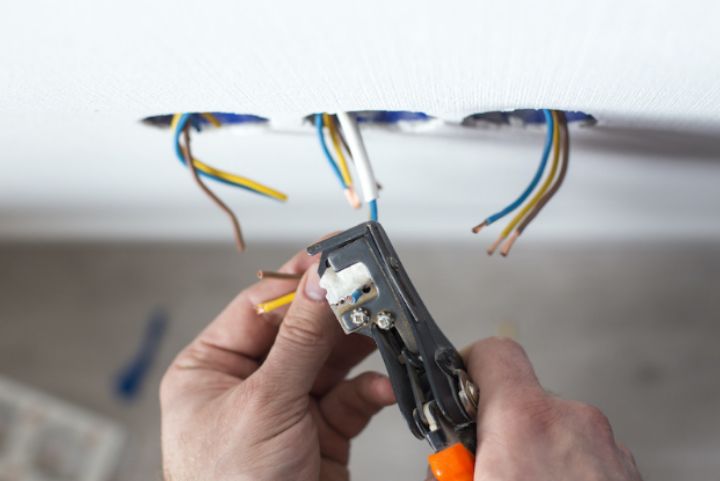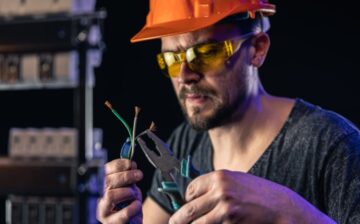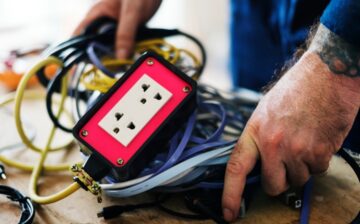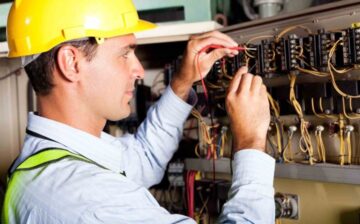
Moving into a new home is exciting, but it’s important to ensure that the wiring is safe and in good condition before you settle in. You need to take an educated approach to protecting yourself from potential electrical dangers before making a dream home a reality.
With this blog, we will discuss how to check the electrical wiring in your new home before moving in – so you can stay safe and make the most of your new life:
Importance of Checking Electrical Wiring Before Moving In
Moving into a new home can be an exciting venture, however it is important to ensure that all of the wiring in your home is working correctly before you move in. Electrical wiring issues can cause significant problems, including power outages, fire hazards and expensive repairs.
By taking some time to check the electrical wiring of your new home, you can make sure everything is working correctly and potentially save yourself a lot of time, money and hassle in the future.
Before making any adjustments to the wiring system, it is important to understand how electricity works within the home. A basic understanding of electricity and its components is key to knowing what to look out for when checking your new home’s wiring. The electrical system within any residence should include:
- A breaker panel that distributes power throughout your house safely and evenly;
- Outlets which are designed to provide convenient access for electrical appliances;
- Switches which control when an appliance operates;
- As well as other components depending on the type of wiring you have installed in your house such as GFCI outlets for added safety around water sources like pools or bathrooms.
By inspecting each component of your home’s electrical system carefully before moving in – either by yourself or with help from a licensed electrician – you can identify potential problems before they become major issues or dangerous situations down the line. Taking this precautionary step before settling into your new home will help ensure that all aspects of your house are safe and functioning properly so you can avoid any costly repairs or worse danger down the road.
Hire a Professional Electrician
Before purchasing any property, it is important to hire a local electrical company to inspect the electrical wiring and make sure it meets safety standards. An experienced electrician can determine if the wiring has been correctly installed and test all of the components, such as circuit breakers and outlets, to ensure they’re functioning properly. Additionally, an electrician will be able to detect any issues that could be present in more hard-to-reach areas, such as behind walls or in the attic.
It is far better to identify and repair problems before moving into a new home than after you have signed a contract for purchase.
It is crucial that you seek help from an experienced licensed electrician, who will know the local codes required for electrical work in your new property and can provide specialized advice on how best to update or upgrade your home’s electrical system. Electrical systems are incredibly complex, and attempting repairs without the proper knowledge can damage wires or create dangerous situations. A professional electrician will also be equipped with all of the necessary tools for even more thorough inspections of hidden wiring systems.
Check the Electrical Panel
The most important check you should do when inspecting a new home’s electrical wiring is to check the electrical panel. The electrical panel should be labeled, and it’s important to understand what type of circuit breaker and fuses power your home. The type of breaker/fuse used in your home can determine how many appliances can be connected and what the electricity load limitations are for each appliance. If you are unsure about any of this, it’s best to consult an electrician to help identify potential issues with the system.
When inspecting the electrical panel, make sure that there is enough space between all elements, including fuses, breakers, wiring and switches. All screws should be tight and secure, and all circuit breakers should be in the off position when not in use. Additionally, verify that all outlets meet current safety codes by confirming that they are equipped with GFI/GFCI devices (ground fault interrupter). Lastly, inspect the age of wiring in your panels as old wiring may pose an issue due to lack of grounding protection or insufficient insulation around wires.
Inspect Outlets and Switches
When it comes to inspecting electrical wiring in your new home, it’s important to inspect both outlets and switches. Both these fixtures can be worn down with age or become faulty due to improper installation. Checking them before turning on the power is worth your time and effort.
When inspecting outlets, look for exposed wiring, burnt areas, or blackened socket plates. Make sure that the covers all fit correctly so that no little fingers can get into them. If there are any missing outlet covers then you should replace them immediately with child-proof ones. You should check for wiring problems in each outlet by plugging a small lamp or nightlight firmly into the outlet and observing if it lights up safely and properly.
Switches must also be checked for proper installation, proper visible grounding wire systems, protected wiring in junction boxes, and secure mounting of both boxes and switches. Turn on each switch several times as well as flick it from top to bottom to see if it functions properly. If a switch does not seem to respond or does not “click” on or off then you may need to replace the switch itself or have an electrician inspect and use a live voltage tester on the switch itself before turning it back on.
Test Light Fixtures
Before you move into your new home, check the light fixtures to ensure they are operating safely. First, turn off the power at the main breaker in your circuit panel or fuse box. Open up each light housing and inspect them for signs of wear and tear such as broken glass, frayed wiring, or loose connections. Use a voltage tester to measure if any electrical wiring is live when not expected to be so. Make sure all wiring is in good condition and that nothing looks suspicious before proceeding with testing the lights.
Once everything looks good, turn the power back on and test each fixture one by one. Make sure all bulbs are screwed in correctly and that all connections are working correctly before flipping on each light switch. Finally, examine carefully for any flickering or dimming of lights throughout the household as this could indicate a bigger electrical problem further down the line. Once you are finished with your inspection, make sure all light switches are off and the power is turned off at your circuit panel or fuse box again to be extra safe!
Examine the Wiring in Appliances
In addition to checking the external wiring of your home, you should also examine the wiring within electrical appliances. The wiring in all of your appliances may not be exposed, yet it is still an important factor when considering a new home. If a home has not gone through regular maintenance, it is possible that the wiring in the appliances has become frayed or corroded over time.
One way to prevent electrical fires is to inspect this wiring carefully before plugging any appliance into an outlet. If you do not feel comfortable inspecting the internal workings of any appliance or have trouble locating certain elements of its internal electrical system, consider bringing in a qualified electrician or appliance repair technician who can provide analysis and advice on any issues found.
Be sure to check all major appliances such as dishwashers, microwaves, refrigerators and ovens for any signs of fraying or other damage. The added security this check provides can be invaluable in helping you move into your new home without the risk of potential fire hazards due to faulty wiring.
Inspect the Grounding System
The grounding system is an important part of the electrical system and should be inspected prior to closing on your new home. To establish a continuing ground, every electrical outlet must be attached to the grounding conductor. Check both the inside and outside outlets for this. In some cases, it may appear that an outlet has been properly grounded with one ground wire when in reality there may be two. The second may not be visible because it has been installed inside of a box or casing.
An easy way to check for proper grounding is with a three-prong outlet tester. This device cost around ten dollars and helps you determine if an outlet is correctly grounded or not. For additional safety, have a qualified electrician check the outside outlets using an ohmmeter as well as any appliance circuitry connected directly to the house’s main power source like:
- air conditioning
- clothes dryers
- water heaters
Look for Signs of Previous Electrical Work
When inspecting the electrical system in a new home, be sure to check for signs of previous electrical work. This includes examining wires and outlets for fraying or corrosion and making sure that the wiring does not look overloaded. It is also a good idea to look for changes in the level of insulation around wires, as well as any dirt or debris that could be obstructing vent openings and airways. If you find evidence of previous electrical work, it is important to determine whether it was done correctly.
Additionally, when inspecting electrical wiring prior to moving into a new home, inspect switches, light fixtures, and other devices. Check that they appear in good condition with no signs of wear or damage, such as loose connections or burned out bulbs. If necessary replace any damaged components with new parts before turning on the power. Look for faulty wiring caused by loose connections at switches and plugs which could lead to electric shocks when operating an appliance or electric tool without properly insulated gloves or footwear. Test each socket outlet with a circuit tester before connecting any appliances or tools to ensure safety.
Check for Frayed or Damaged Wiring
When inspecting the wiring in your new home, it is important to check for any evidence of fraying or damage to the wiring and insulation. Visibly inspect the wires for any cuts and tears. Additionally, use a Voltage Tester or a Continuity Tester to check for potential wiring issues. Make sure that no wires are worn through and that they securely fit in their assigned terminals.
It is also important to look at the outlet covers, making sure that they are firmly fit over their respective outlets. If there are loose or broken covers, this indicates wear and tear, which may require replacement of the outlets as soon as possible before you move in. Additionally, check if all wall switches work properly and if each lighting fixture safely eases into its outlet holder on your walls.
Overall electrical safety is paramount when conducting an inspection. Thus, it is best if this task is undertaken by a qualified electrician who can give an expert assessment of the home’s current state and recommend improvements where necessary.
Conclusion
In conclusion, checking the electrical wiring in your new home is an important part of preparing for a successful move. By testing each circuit, using a voltage tester, you can ensure that all wiring has been correctly installed and that no damage has occurred. It’s also wise to take into account any known age of the home, as older wiring may need to be updated for safety reasons.
Finally, consult a qualified electrician for any major repairs or replacements if you discover any issues with your new home’s electrical wiring. Taking these simple precautions can help you keep your family safe and save money in the long run.
We hope you found this blog post on How to Check the Electrical Wiring in Your New Home Before Moving In, useful. Be sure to check out our post on Choose The Right Electrical Service In Emergency Conditions for more great tips!
Have Experience in the Moving Industry? Want an Additional Income Stream? Work With All Around Moving!
Partner with All Around Moving Services Company, and we’ll help you make money by establishing your own moving consultant business. Click here to learn more.





